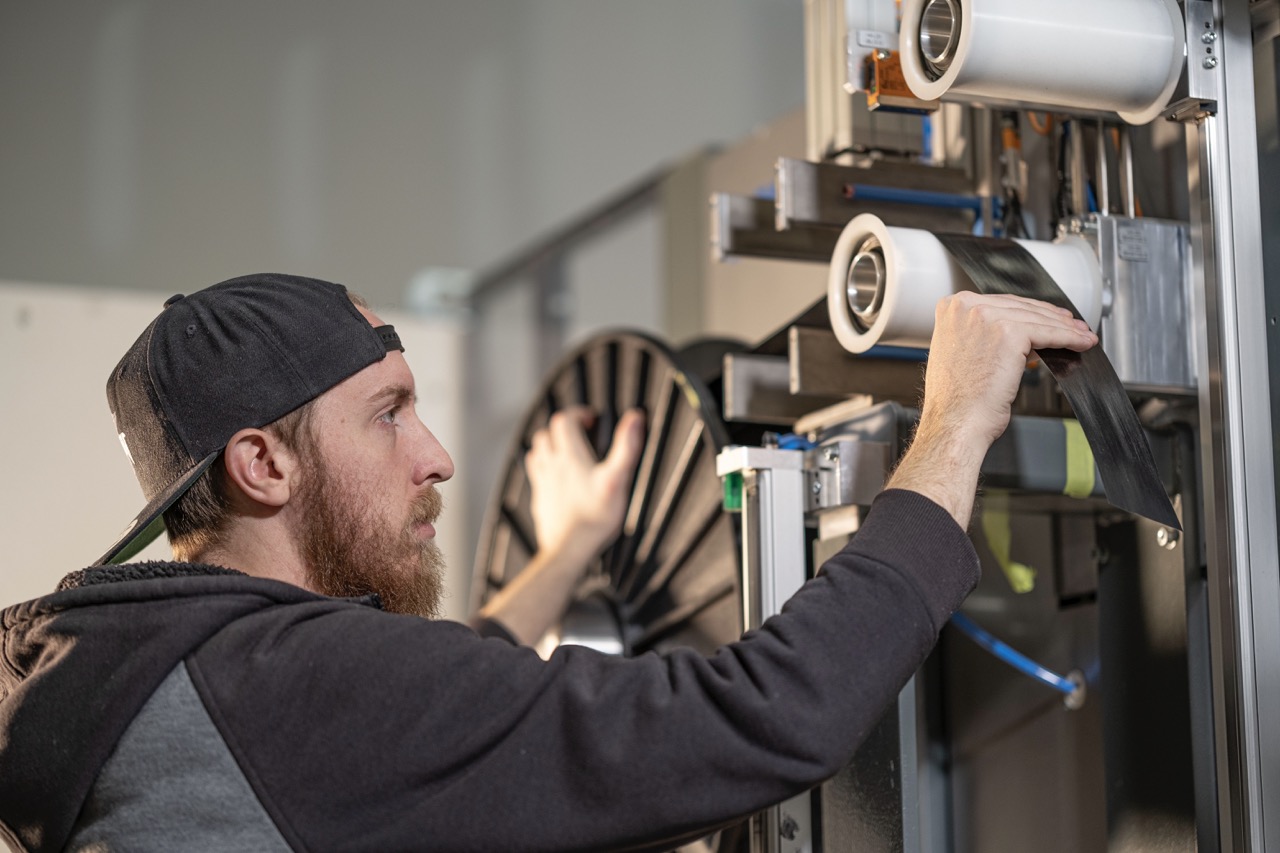
Gunnison, Utah, has a Subway, a gas station with diesel fuel – and not much else. It’s a small, quiet town about 2 hours south of Salt Lake City. Everyone knows each other in Gunnison, but not everyone knows the town’s best-kept secret: one of its proudest institutions is poised to upend a global industry at scale – all with clean energy and almost zero waste.
Seriously.

Carbon fiber is a dirty business
So, carbon fiber looks cool. However, making carbon fiber is tedious and leads to a lot of waste that can’t be reclaimed in “normal” processing facilities.
The layers of a traditional carbon fiber product are laid out by hand. Each layer must be precisely cut and laid out by humans, who have little room for error. Moreover, each layer requires an adhesive to bond the structure, which adds even more complexity and failure points.
Once the layers and adhesive are in place, the carbon fiber unit being produced often has to be placed in a special vacuum-sealed bag over a mold to compress the layers and extract air, which can take several days, depending on the item being produced.
Carbon fiber pieces are then fired in a massive autoclave (like a kiln to bond the adhesives), which requires that the temperature be scaled up and cooled at a specific rate. When heating and cooling pieces, it’s rare that two unique parts have the same heating and cooling needs. That means the giant kilns have to be filled with one specific part, which means the facility has to have enough orders to make a production run worthwhile, which also means fulfilling other orders has to wait. (When a large order comes in from a major customer, this can also bump production back.)
Each step in this process requires human hands and a delicate process, and here’s where carbon fiber gets tricky: if, at any stage, things don’t go perfectly, the piece being produced cannot be used and is relegated to the trash heap. If the error occurs in heating and cooling, the entire production run might be lost.
You can’t recycle traditional carbon fiber, and it must be kept in a refrigerated environment due to its adhesive layers, which aren’t shelf-stable. Carbon fiber has a short shelf life; if you can’t use the frozen material in about six months, it probably needs to be discarded.
If you do get to use the materials and make something that isn’t up to standard, it’s never going to be, and that’s that. Typically, 30 percent or more of carbon fiber goods do not meet quality control measures for various reasons.
Because carbon fiber is a tedious and tender process, affordability is a concern. Much of the carbon fiber manufacturing is now done overseas to reduce labor costs, which introduces other concerns, like labor and employee safety issues.

Forge+Bond (and carbon fiber)
CSS was founded in 2019. CEO and co-founder Jason Christensen started his career in carbon fiber at a company his father started (also based in Gunnison), which makes parts and components for some of the largest companies on Earth, including several aerospace companies. After a discovery that Christensen felt would revolutionize carbon fiber manufacturing as we know it, he started down a new path to explore just how deep that rabbit hole goes.
It might be endless.
I was recently invited to Gunnison to see how carbon fiber is made in a traditional facility and how CSS sees the future of carbon fiber manufacturing. After a tour of one of its older manufacturing facilities, I was invited to a small area in the recesses of a factory, where a lone machine and spools of material sat.
One man was operating the machine, and he had stacks of what I later learned were the beginnings of a Forge+Bond carbon fiber mountain bike wheel. The spools were FusionFiber, a carbon fiber material that eschews adhesives; instead, FusionFiber uses nylon to bond pieces together. When heated, the nylon acts as the adhesive, bonding layers and pieces together.
FusionFiber is what led Christensen to forge ahead on a different path; it was clear that FusionFiber is radically different.
The giant machine cut several layers from the spool and laid these pieces out on a table before spot-tacking them together. The entire process was done within a minute and replaced the work over a dozen people in the traditional facility would do over several hours or days. The machine uses an automated process based on designs created by humans. Think of it like a 3D printer; rather than building a structure, it’s cutting and tacking layers of FusionFiber.
After the pieces were cut, plotted, and tacked together by the machine, this raw component assembly was sent through another part of the machine, which heat-pressed and cooled the layers; again, a process that took under a minute and replaced several person-hours. The resulting piece was a bonded piece of carbon fiber material that was pliable but firm.

The future is killing the past
These bonded sheets of FusionFiber were then sent to a different facility a few hundred yards away, where they would undergo a process that turned them into lateral halves of mountain bike wheels. Each sheet was heated and molded into one half of a wheel, then fused with another half. There’s also a machine that precision-cuts holes for spokes and a team that places spokes in wheels with a desired amount of tension. FusionFiber can be trimmed with jets of water before being finished by hand, too.
Some processes can’t be completely automated. Like traditional carbon fiber manufacturing, humans have a role to play. This new processing method won’t cost people their jobs; it simply means re-skilling or upskilling existing staff. Someone who carefully laid layers of delicate carbon fiber in the traditional facility may one day fit machine-made layers into specialty-designed molds or operate a press, for instance.
Throughout this “new” facility, I saw giant boxes of trim from wheel manufacturing and wheels that didn’t pass quality control measures. These big boxes would be destined for the landfill in a traditional facility. Here, the trim is set for grinding and experimentation with new products.

What can you do with FusionFiber trim?
I was shown to a different part of the facility where they were placing FusionFiber trim into molds, which were then placed into special ovens that heat and compress the molds, which forced the FusionFiber into the shape of the mold.
It can be reheated because FusionFiber uses nylon as a bonding agent instead of adhesives and laminates. This alone is revolutionary. Traditional carbon fiber, with its various adhesives and layers, can’t be reheated for use in a different way, and if it were to be chopped up and used in a mold like FusionFiber, you’d end up with a volatile, toxic mess instead of a usable product.
This means FusionFiber can be formed into new shapes, too. Forge+Bond makes tire levers out of recycled FusionFiber. My tour included a stop at a station where a technician was molding trim pieces into a tire lever, which took 12 minutes to complete. Trim goes into a mold, which is then placed into a heated press for a set amount of time before the mold is moved to another area to cool down appropriately. In a matter of minutes, I had a usable tire lever, which the team tells me needs no “curing” time other than the time it takes to come to room temperature.
The team at the facility reminds me that pieces made from recycled materials aren’t as structurally sound as first-run FusionFiber components, so we won’t see a fully recycled wheel, for instance. They have to make considerations concerning how thin a piece can be and its purpose. The extreme force a wheel experiences and the variable conditions encountered in mountain biking aren’t great for recycled wheels.
Still, there is a lot that can be done with recycled FusionFiber. The materials and processes Forge+Bond utilizes mean less waste compared to traditional carbon fiber manufacturing, and the ability to reuse FusionFiber in other components means the process only has 0.7 percent waste. The waste that can’t be claimed for recycling is primarily dust and sliver remnants from drilling and trimming during production.
While I was touring the facility, a team was working on producing a new component. Like any research and development test, the results were largely imperfect, which almost didn’t matter; instead of ending up as trash, the items the team was attempting to mold would end up in the recycling bins I walked past moments ago.

This is a massive change in carbon fiber manufacturing
There’s little that can’t be done with FusionFiber, which will be the gift and the curse for CSS and Forge+Bond.
A tire lever is banal but an excellent example of why FusionFiber matters. When changing a mountain bike tire, you exert a lot of pressure on the lever to remove the tire. It’s a proof of concept for Forge+Bond, showcasing that recycled FusionFiber produces items that are still usable and not delicate or decorative.
FusionFiber also has a nearly unlimited shelf life. Traditional carbon fiber components have complex labeling systems and codes to indicate what the layers and adhesives are. When I asked how long the FusionFiber spools had been sitting on the shelf near the lonely machine, cutting and fusing layers, nobody knew. It didn’t matter. It isn’t perishable.

The future of carbon fiber
We think highly of Forge+Bond wheels. Those wheels, while incredibly performant, are proofs of concept, too. They show the world FusionFiber can be used to produce a carbon fiber product that stands up to the most rigorous wear and tear humans can throw at it.
This isn’t about end-user products, though. We’re not here to tell you all the neat things FusionFiber can do because FusionFiber can do anything traditional carbon fiber can. This is about what FusionFiber can do that traditional materials and processes can’t.
After I toured the facility, I was driven back to Salt Lake City to catch my flight home. I was running through all the things Fusionfiber could do; really, I was trying to think of something it couldn’t do. I failed. I want my snowboard bindings to be FusionFiber. I’d take FusionFiber luggage, too. Would this be useful for skiing? The mind races once you’ve seen the future.
The car ride was quiet; eventually, one of my hosts asked, “So, is your mind blown?”
“Do you guys just walk around and point at things and say ‘let’s make that’?” I asked.
There was a brief silence, then a laugh. “Basically, yeah.”
It’s an exciting concept: street signs, utility box covers, cake and cookie display platforms at bakeries, napkin dispensers, road hazard cones, doorknobs, chess pieces, workout equipment, coffee mugs, shoe horns, and components on satellites in space or deep under the surface of the sea. All of these things and more are possible with FusionFiber. The future of stuff could very well be fully circular. That is mind-blowing.
And if I’m wrong and we really can’t make all those things with FusionFiber, who cares – it’s all recyclable anyway. They’ll make other fantastic products I haven’t thought of.
I just hope the ones I have thought of arrive soon.



